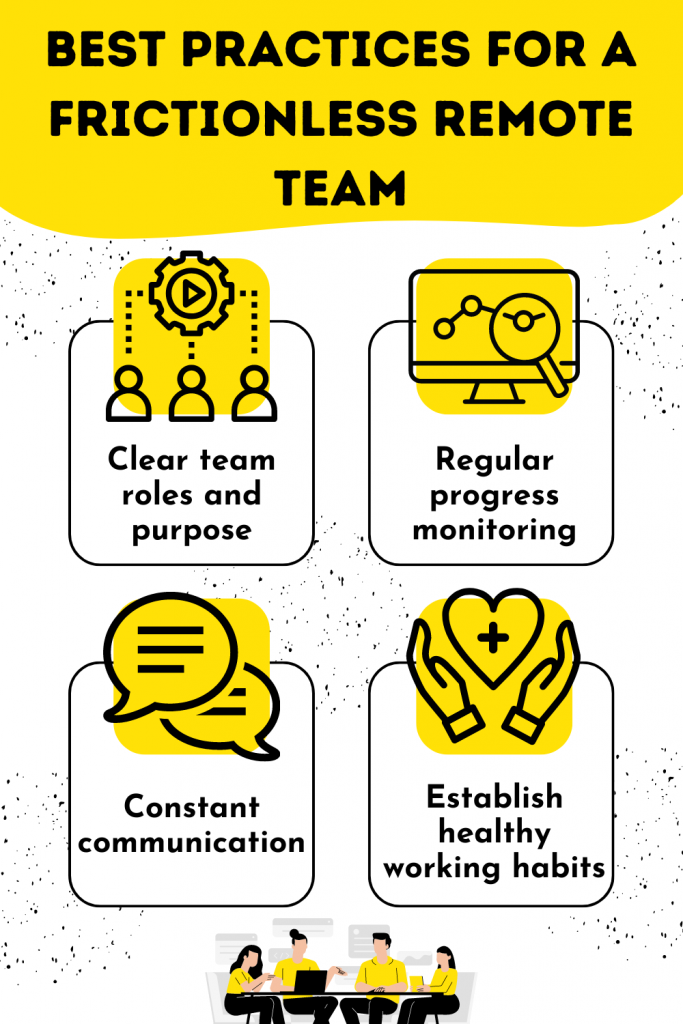
How to Create a Successful Remote Team
CATEGORIES
Tags
24/7 analytics australia automation Business Process Outsourcing company Copywriting CRM customer support data data and analytics Delegate digital digital advertising digital marketing Digital Support Staff ecommerce Email Management Email Marketing Entrepreneur Freelance Writers google ads graphic design Hiring Freelancers Marketing offshore offshoring ominchannel support organizer outsource Outsourcing Philippines Project management reporting seo seo audit Shopify Small Business social media Social media experts social media management United States video Virtual Assistant Virtual Team
A successful remote team gets work done, lowers overhead costs, expands your reach to global talent, and integrates work-life balance. Minimizing the exposure risks in the pandemic forced businesses to explore remote work. And there’s no going back.
Everyone felt the perks of working from home and the setup became an attractive option for employers and employees alike. Far from the expectations of productivity suffering, studies since 2020 have found productivity actually stayed the same or even soared for many industries.
So how do you create a successful remote team? It doesn’t happen overnight. You need an effective plan, the right tools, and hands-on supervision, with just enough accountability in place without suffocating everybody.
Consider the type of remote work best for your teams

Consider which type would be best for your company or specific teams. For example, customer-facing teams might need to have rotating shifts on-site. Collaborative teams would usually need to have on-site huddles now and then, although even this can be done online, with the right tools.
Fully Remote: 100% remote, with a fixed or free schedule of work. Some companies keep the same work hours. Some give free rein to their employees as long as the work is getting done, though this does remove a lot of structure and should only be offered to managers or members of your team you trust.
Everyone signs on to a chosen collaboration platform like Slack, Trello, and ClickUp, and communicates and updates on work progress there. You hold meetings via Google Meet or Zoom or stay in touch via audio.
Hybrid: A flexible work arrangement, you and your teams have complete freedom in your office and remote days. Some companies set a specific number of hours to be completed per month or week at the office, some give free rein according to actual need.
This freedom of choice is nice to have. Hybrid is the most preferred option for workers worldwide. People still do want to go to the office. They just want it on their terms and they definitely want to keep the convenience, safety, and time and money saved when working majorly from home.
Look at the tasks you can do remotely: Think of security and standardize your processes
Most business processes can be completed remotely, with the right setup for file safety and compliance with privacy and security laws. You also want to establish SOPs so there’s clarity in your expectations and uniformity and consistency in your team’s output.
These are the tasks you and your team can confidently do remotely.
Ecommerce Administration: Your remote eCommerce team handles your online business from product listing to customer support, and takes care of repetitive tasks.

Graphic Design: You send a brief with the details on feedback rounds of initial designs to the final submission. Graphic designers work great remotely. You can use tools in the Adobe Suite for convenient markups and feedback on the actual layout.

Digital Advertising, SEO, Reporting, and Analytics: These task categories do well remotely with a clear brief on goals, KPIs, and budgets. Face-to-face meetings may be necessary for strategy huddles and the submission or presentation of reports.

Web Development: Teams working on big projects may need to meet or stay connected while working remotely, but web development is another task with a long history of remote work.

Content Marketing– Email, Social Media, Copywriting: Emails, captions, product descriptions, blogs, and articles are all perfectly done well by writers working remotely. In fact, most writers thrive better in a quiet setting free of distractions and sensory triggers.

Customer Support: With the right platforms like helpdesk ticket systems and chat tools, customer support can be accomplished remotely via email or live chat, round the clock, or during set business hours.

Social Media Management: Social media scheduling tools have been around for years, convenient for delegating your social media management remotely. On actual logins, security has been tightened and 2FA can be tricky, but once the social media platform recognizes your remote teams’ devices, it’s a breeze to engage with comments and communities.

Back Office Administration: Remote doesn’t mean any less seamless when it comes to your virtual assistant teams. Admin work goes far back in remote work. Google Drive, Dropbox, SmartSheet, and other platforms and tools were built for collaborative administrative work without the need for the same office network.

Set up tools for your remote team

Your success depends on your employee’s productivity as you rely on them to finish daily tasks. Keep efficiency up and stress levels low with the right tools and platforms.
Choose tools that pull double duty with communication lines. They should also show everyone’s touch-points–who worked on what– so you have accountability.
Virtual Set-Up: Provide your remote team with the right technology to fulfill their specific tasks. A fast internet connection from 25mbps or more, and an up-to-date computer is an essential starter packs. Higher specifications are required as laggy equipment hinders employee efficiency: 8GB-16GB RAM, 256GB SSD, or more are now standards and basic.
Your web developers and graphic designers need more powerful specs.
Unified Communication Tools: Build virtual offices on instant messaging tools like Slack, Skype, or Microsoft Teams to communicate with your employees, segmenting them on different channels.
Stay updated on their daily tasks and reports. Have regularly scheduled updates on ongoing projects or check-ins with clients.
Over-communication is a practice to create a successful remote team.
Video Conferencing Software: Enable meetings and conferences online through Google Meet, MS Teams, Zoom, Cisco, or your chosen app. Some are free to use – with paid tiers – giving you more security, features, and ways to collaborate.
Computer Tracking Software and Time Tracking Tools: Use Time Tracking software your team can turn on and off as they work on specific tasks and clients or projects. Upwork, Hubstaff, Time Doctor, and ClickUp, all have time-tracking tools you can utilize. It can be an incredibly effective tool to improve productivity and team performance if used correctly.
Screen Recording Applications: Transform your work and don’t miss any detail by backing up your video conferences, calls, and meetings. This is also handy for training/onboarding new hires. Just record what they’re supposed to do and they can consult the video any time.
OBS, ScreenFlow, and Bandicam record calls and presentations.
Project Management Tools: Monitor project updates on free tools to list, delegate, and quantify your remote team tasks. Free collaboration tools like Asana, Trello, ClickUp, and ProofHub are available to use as a workspace and virtual desks.
Cloud Storage Tools: Keep your files safe, secure, and accessible to specific team members. Create folders and control access on platforms like Google Drive, OneDrive, and DropBox. Make it easier for everyone in your virtual team to access necessary files when needed.
Cloud-based Payroll: Your remote team can clock in and out from cost-effective payroll management tools that track employees working cycle from attendance to leaves on a centralized source of data.
Best Practices For A Frictionless Remote Team

Clarify roles and team purposes: From specific tasks, job descriptions, and roles as members of their remote teams, every employee must know what they are expected to achieve and accomplish within specific time frames.
Make sure everyone knows they can ask questions and raise concerns.
Monitor Capacity and Progress: Be aware of how your remote team is doing. Are there any bottlenecks in processes or your employee’s growth? Keep checking if there are improvements you can make and better tools you can switch to.
Assess priorities and understand what your remote team lacks.
Continuously monitor the capacity of your employees and work progress to make sure everyone’s being productive. Aside from being a drain on your bottom line, idle hours can breed disconnection and ultimately, employee churn when that employee no longer feels needed and quits.
Over-communication Strategy: There is no over-communication for a remote team. Encourage and appreciate frequent updates. Integrate and standardize using communication and project management tools to update progress, notify tasks completions, or simply give employees a space to talk to each other. People miss that ability to chat at the office. It doesn’t have to be completely gone.
Make yourself available, and stay online during working hours to converse and receive emails, reports, and updates.
Establish Healthy Working Habits: A virtual office exists inside communication software. Start the day with greetings and schedules so you know what’s on everyone’s plates.
When you see something not so right, like clocking in late, not posting their schedule, or something as simple as a lack of courtesy and warmth in messages, nip it in the bud. You set what you want to see. Be firm about your workplace culture practices.
Prioritize work-life balance to your productive remote team. Encourage healthy work maps with clear goals and trust your team for great results.
USource’s Successful Remote Team

We continue to be proud of how far we’ve come and how smoothly we’ve transitioned since switching to 100% remote–and now hybrid– work. At the time of writing, we have ~120 employees spread across several locations in the Philippines.
Our office is open and operational and is always an option for our team members whenever they want a change of location to work. Our operations team rotates with shifts at the office.
Here are some highlights of what we do:
Maximize technology in all operations
Every USource employee is trained to use various communication tools, project management apps, data recording systems, and software basics to effectively connect, delegate and accomplish tasks, and produce results within deadlines.
Our attendance is monitored on a payroll system. Work is tracked through several time trackers. We also have regular meetings and catch-ups via Google Meet and Slack.
Healthy working environment
Our remote team works on a consistent schedule. Tasks are divided into different teams with specific skill sets and responsibilities. To ensure quality work, managers openly communicate with members for updates and edits on tasks, and assignments, and for upskilling.
USource encourages and respects work-life balance with paid breaks, no sudden overtime, and appropriate working hours.
Open communications
Using Slack, USource teams have specific channels for their teams, their managers, every client, and every category of work. For example, several colleagues and teams can collaborate in the Team Content channel– which covers everything from articles to social media captions. In our General channel, we post birthday greetings and might post jokes.
Every team has its channel where they can consult each other about work and everything else, and can send a DM to their managers any time (but where possible we encourage open communication).
With our client’s permission, we also set up Slack for them, and stay in touch through their own established platforms like Skype, MS Teams, Trello, ClickUp, Asana, and email.
We have centralized our communication tickets, via Freshdesk, to foster collaboration and accountability. Managers can make sure clients always receive prompt replies.
Professional work culture
Professionalism draws a bold line between being at work while at home. As mentioned above in communication, our standard is to have prompt responses to our clients, and each other.
Our work culture is respectful and ethical, informal but always in tune with our client’s styles and needs.
We’ve also established data and security features and made sure we’re compliant with local employment laws, to protect you as a client, your data, and our remote employees.
Our clients in the United States, the UK, Australia, Canada, Europe, and Southeast Asia keep coming back. They know their tasks get done with us, and we’ve already experienced and smoothed most of the friction that inevitably comes up in outsourcing.
Building a successful remote team boils down to providing your team with tools for success: open communication and established standards for their work and processes. That’s it!

